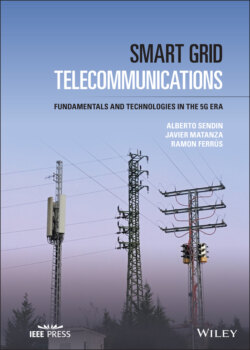Читать книгу Smart Grid Telecommunications - Ramon Ferrús - Страница 40
1.6.1 Telecommunication Solutions for Smart Grids
ОглавлениеSmart Grid infrastructure refresh cycles are much slower than telecommunication's. In general terms, we could say that the useful lifetime of a grid technology is always higher than any telecommunication solution that could be used in it, with factors ranging from 1.2 to 2.5 (see examples in [44]). If a telecommunications solution is to be found for a specific Smart Grid need, it is not just the requirements, or the basic technology supporting it that deserves attention, but the way in which the telecommunication solutions are to be sustained over time and how to better approach this.
The consideration clearly exceeds technical aspects, but probably economic aspects as well, as the feasibility of modifying infrastructure aspects on the grid must be limited in order not to affect grid reliability or to interfere with normal grid operation. Thus, substations cannot be frequently stopped, and customers cannot be visited without a good reason.
There is an inherent risk of making wrong choices when deciding on the telecommunication solutions for Smart Grids:
The technology assessment period (including analysis, proof of concept, service adjustment, and tender process) may take so long that a relevant percentage of the product or service lifecycle is gone.
The network or service deployment rhythm, as it is encompassed with the grid infrastructure delivery, may take so long that a relevant percentage of the product or service lifecycle is gone.
If the selection of the technology involves a service provided by a TSP, the availability of the service or its service conditions may vary over time, and it may invalidate products developed to adapt to this service.
Utilities usually take some measures to adapt to these risks:
Private telecommunication network solutions are chosen, even if there are commercially available alternatives, to avoid that their investments or costs are decided outside their industry.
Access to niche telecommunication solutions and product vendors. Apart from the grid knowledge of many of these vendors, they offer their solutions with long‐term availability commitments.
Integration of telecommunication solutions and even technology inside grid elements. The use of assets that are intrinsically part of the grid (optical fiber cables, PLC, etc.) guarantee that they evolve as the grid infrastructure does.
Integration of replaceable telecommunication modules within the devices to be connected, or as separate boxes connected through simple standard interfaces, to minimize disruptions due to external changes.
All these precautions come with a price. Private telecommunications network solutions require an expertise that needs to be found within the utility, contracted as a service, or existing within niche TSPs. Niche solutions have the handicap that they are not usually best of breed, as they are not based on the ultimate knowledge and resources from market leaders; moreover, as the niche market may be comparatively small, the attraction of competitors is limited, so that it may end up with prices (costs) that are not competitive. Integration of telecommunication solutions within the grid requires that utilities open their grids to telecommunication experts so that the field they need to explore is available to develop and test new ideas; this might not be easy being the grid a place where safety and reliability of service is a key aspect.
Thus, there are some considerations to observe when designing the Smart Grid evolution with Telecommunications:
Smart grids telecommunication solutions must be always understood as a moving target; i.e., any solution, while in the process of being delivered, must be managed observing its next evolutionary step, as due to the longer technology cycles in Smart Grids, telecommunication solutions will change faster that Smart Grid ones.
Telecommunications solutions must come to the Smart Grid infrastructure in the form of technological waves that will be applied to the existing grids, in such a way that along the life cycle of a grid asset, several evolutionary telecommunication solutions will be applied.
Requirements imposed by the Smart Grid must be realistic but challenging, to find a solution within the existing solutions, while simultaneously providing requirements to the next wave of telecommunication solutions for Smart Grids.
Telecommunication solutions must be scalable, meaning that networks and network end‐points will be able to increase in extension and number (respectively) without general network degradation.
No single solution will ever exist for the “smarter grid.” All Smart Grid evolutions will be a consequence of complex decisions, based on regulatory and business aspects, electric and telecommunications technical, and strategy considerations that will configure unique solutions.
